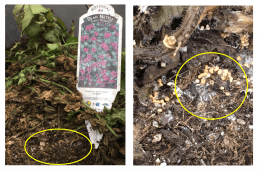By: Judy O’Mara
A little unusual… this past week a fungal disease called southern blight took out a landscape planting of Lamium or dead nettle in south central Kansas. In my years at K-State, I’ve seen southern blight occur on hosta plantings a few times and have also picked it up on Echinacea, Hibiscus, Liatris, Pasque Flower, Penstemon, Rudbeckia, Solidago, as well as, tomato. Southern blight (Sclerotium rolfsii; Athelia rolfsii) is a serious disease, particularly in the south (hence the name). It has a history of being damaging to over 500 plant species including field crops, vegetables, flowers, weeds, and even some woody landscape plants.
Plants infected by the southern blight fungus may wilt quickly and collapse, or they may turn yellow and slowly decline. There are frequently dark stem lesions at the base of the plant, a crown rot and/or a root rot. The most distinctive symptoms of southern blight are the presence of sclerotia and a white matt of fungal mycelium. Sclerotia are small seed-shaped fungal structures that allow the disease to survive in plant debris and soil for several years. They range in color from light tan to reddish-brown becoming somewhat inconspicuous as they age. A fan of white mycelium may grow along the basal stem lesion or in the soil.

While southern blight is a serious disease, it is not that common in Kansas. When it does occur here, it tends to show up during July and August under hot, wet conditions. The limiting factor for Kansas may be that when we have high temps, it also tends to be dry. Southern blight outbreaks in Kansas have been observed in irrigated landscapes (ie hot + wet). Crowded plantings can create a humid environment that can favor the disease.
Once southern blight shows up in the landscape, it can be a challenge to manage. Infected plants (plus the root ball) should be dug up, bagged and sent to the landfill. Do not compost plants from infested locations, as this can spread the disease across the planting area when the compost material is re-incorporated into the landscape. Rotate out of the infested area for 3-4 years, but make sure to control weeds because they can also serve as a host for the disease.
The bulk of the sclerotia will survive in the upper soil, so deep plowing or inverting the soil can help to reduce the amount of disease in the infested area. Another strategy for reducing southern blight severity, is to employ solarization of the target area. This can be done by covering the area with clear plastic for 4-6 weeks. It will be important to clean and disinfect tools, gloves and shoes after working in areas with southern blight. This will help to limit movement of the disease into new areas of the garden or landscape.
An article in the University of Illinois Home Yard and Garden Pest Newsletter indicated that they are also seeing southern blight activity this summer, particularly on Hosta. Another name for the disease is Hosta Petiole Blight. The article has some great photos of the disease on Hosta, which can be seen at http://hyg.ipm.illinois.edu/article.php?id=1087.